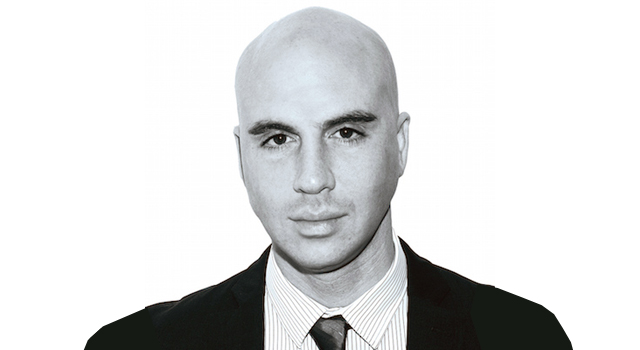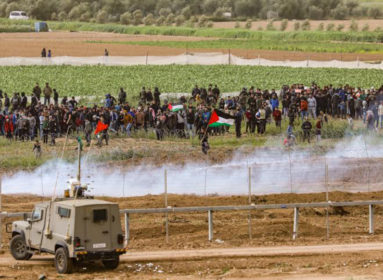
Stamford community-wide Holocaust commemoration celebrates creativity as hope
By Cindy Mindell
STAMFORD – To utter “Holocaust” and “art” in the same sentence may seem dissonant at first. How could Jews living under Nazi occupation and suffering in ghettos and concentration camps have had the wherewithal for artistic expression when every moment was devoted to mere survival?
Therein lies the answer: art was often a means of psychological survival, and the only way to express the horrors of persecution and the mixed emotions of liberation.
This aspect of survival is at the heart of the community-wide Yom Hashoah commemoration, sponsored by the United Jewish Federation of Greater Stamford, New Canaan and Darien (UJF) and held at Temple Sinai in Stamford. The program will include two components.
“The Anguish of Liberation as Reflected in Art,” borrowed from the Traveling Exhibits Division of Yad Vashem, will be on display from Monday, May 2 through Sunday, May 15.
“The Art of Survival,” a program of film, poetry, music, and artwork created during and after the Holocaust, will be held on Wednesday, May 4 at 7 p.m.
The idea for “The Art of Survival” came about last fall, as the planning committee was discussing the upcoming program.
“We had already done a Yom Hashoah seder two years in a row, so we were looking for a different way to organize this year’s commemoration,” says Cantor Marcia Lane, director of Education and Engagement at UJF, who conceived of the arts-focused theme together with Yom Hashoah commemoration committee chair Barbara Webski and UJF CEO Jim Cohen.
The committee began collecting ideas and examples of different arts, and ended up with a wide variety of poetry, art, music, and film. The program includes works created by inmates in the camps and the ghettoes, some of whom did not survive and others who saw liberation; clips from documentary films made after liberation; music created or celebrated during the Shoah. “We have a rather odd example of swing music that flourished in the camps,” Lane says. “Part of the Nazi crackdown on all western music was a crackdown on western swing music. There was a group of young people, most not Jewish, who were interned in camps because they were ‘Swing Kids.’ All these examples happened as a result of the Shoah, and all are ways of celebrating the arts and the place that the arts had in survival and in recovery after the war.”
“The Anguish of Liberation as Reflected in Art” is a 13-panel exhibit from the Traveling Exhibits Division of Yad Vashem that features works created between 1945 and 1947, and now held in the museum’s art collection. The exhibit was first mounted at the Yad Vashem Museum of Holocaust Art last January, to coincide with International Holocaust Remembrance Day and the 70th anniversary of the liberation of Auschwitz.
UJF purchased the right to reproduce the exhibit, whose works “range from joyous to tragic,” Lane says. It is being designed and installed at Temple Sinai by Stamford resident Sherry Steiner, an artist and interior designer.
For the May 4 program, the planning committee expanded the definition of “the art of survival” to include whatever means people used to survive the Holocaust.
“So it’s not just the arts, but it’s also a way of looking at the world, and we celebrate that through our survivors,” Lane says. The program will include several survivors who live in the Greater Stamford community, some of whose stories will be shared through documentary film clips.
Among the films is the work of Weston resident and child Holocaust survivor Agnes Vertes, who has interviewed fellow survivors. The Buchenwald Ball chronicles a group of young men who survived Buchenwald and immigrated to Australia, where they created an annual party to celebrate their liberation, carried on by their children and grandchildren. In the Swedish documentary, Every Face Has a Name, the director tracks down and interviews Holocaust survivors filmed upon their arrival in Sweden after the war. There is a rare film clip showing a dance choreographed by Hartford native and famed modern-dance pioneer Anna Sokolow, who did not endure the Holocaust but created works in reaction to it.
The program will also include artwork by students at Carmel Academy in Greenwich and Bi-Cultural Day School in Stamford, created in response to Holocaust-era poetry. Students from the Jewish High School of Connecticut in Stamford will read letters written by teenagers during the Shoah.
“We know that Yom Hashoah is a time of great sorrow and thoughtfulness,” says Lane. “But we wanted it to be a time to celebrate those people whose contributions, through the arts, were enduring or helped other people to endure, or whose contributions to the arts happened as a result of their liberation and their reaction to the Shoah.”
For information on “The Anguish of Liberation as Reflected in Art” and “The Art of Survival,” visit ujf.org.
Eliana’s story of survival inspires New Haven students… En Español
By Markeshia Ricks
 Eliazer asked Eliana Matalon in Spanish how to deal with the memories — of gangs snatching people and killing them in front of him — that he has of trying to get from Guatemala to the United States. Matalon, a Holocaust survivor, replied in the same tongue: Don’t dwell on them. Focus on getting an education. Improve yourself. Become a good man.
Eliazer asked Eliana Matalon in Spanish how to deal with the memories — of gangs snatching people and killing them in front of him — that he has of trying to get from Guatemala to the United States. Matalon, a Holocaust survivor, replied in the same tongue: Don’t dwell on them. Focus on getting an education. Improve yourself. Become a good man.
A Holocaust survivor isn’t an everyday sighting in a Fair Haven School classroom. Nor is a Holocaust survivor speaking fluent Spanish.
Both those sightings took place Thursday, Feb. 4 in a classroom at Fair Haven School.
Matalon, an 80-year-old Newtown resident by way of Belgium and other European and South American countries in between, stopped by to talk to the fifth and sixth grade students of bilingual teacher David Weinreb. A few months ago the students finished a book called Hana’s Suitcase, in which they learned about a Japanese Holocaust museum curator’s quest to unearth the story of a young Jewish girl, Hana Brady, executed in the gas chambers at Auschwitz.
Weinreb, who teaches about 80 percent of his class in Spanish, said his students, many from Puerto Rico and countries like Guatemala and Ecuador, had no knowledge of Jewish people prior to reading the book. But he said they greatly identified with the story of having to flee their country. Many of Weinreb’s students are in a classroom on U.S. soil for the first time in their young lives.
“My students from Guatemala and Ecuador have done some crazy things to get here,” he said. “Not many are running from a war, but a bunch of their parents have said to me that they left because it wasn’t safe, that they wanted their child to be in a place that was safe.”
Given their engagement with Hana’s story, Weinreb decided to reach out to an organization that his father, Daniel, is connected to, The Holocaust and Human Rights Education Center in White Plains and its speaker’s bureau, with hopes of finding a Spanish-speaking Holocaust survivor.
The quest stalled immediately. He persisted. That tenacity led him to Matalon.
Born in Belgium just five years after Hana Brady, Matalon shared a different side of the terror — the survival side — that Jewish families like hers encountered escaping Nazi-occupied Europe. She was only four years old when the family fled their home in Belgium. They narrowly survived a bombing near the French border. She and her mother were forced to separate from her father when he was conscripted to fight in the Czechoslovakian army.
They were forced into a detention camp with no food near the border of Spain. She witnessed a mother and child killed by a train when the trainmaster wouldn’t stop it so the mother could get her child off. An altercation with the trainmaster landed her father in jail. Such incidents would dot her young life until the family reconnected with relatives in Brazil and later in Argentina.
Matalon knows what it’s like to be undocumented. The family had to return to Europe because it lacked the proper documents. Soon after it was forced into a German concentration camp. The life was not easy, she told the students in Spanish. But the family survived, eventually returning to Argentina for good when she was almost seven.
Despite the terrifying start to her life, Matalon grew up to study at the University of London, learn nine languages and immigrate to the U.S. in 1970. She told the students that no matter what happened in their lives before they arrived here, going forward, they should dedicate their lives to improving themselves, to studying and being a good person.
“Believe in the kindness of the human race,” she said afterward in English. “If you want to become somebody, you can.”
Weinreb said the class has been exploring human rights. It is now reading a book about a Mexican family living and working as itinerant farmers in California in the 1960s.
“It’s hitting closer to home in some ways,” he said.
Through the book’s characters the students are confronting the idea of being forced to speak only English in a classroom. They compare that idea to their own experience of attending a school that encourages students to celebrate their culture and their language by not forcing them to learn English right away.
The Feb. 5 cross-culture, intergenerational dialogue was a proud moment for Weinreb, who is Jewish and the grandson of a Holocaust survivor.
“This matters to me because it’s what we’re reading, and Holocaust survivor education and social justice education is part and parcel of my family identity,” he said. “To see them so engaged and asking such strong questions—I just love the practice they got today.”
This article is reprinted with permission of the New Haven Independent (www.newhavenindependent.org), where it first appeared on Feb. 5, 2016.
A tale of Holocaust darkness and survival… in Norway
By Cindy Mindell
For nearly 45 years, Irene Levin Berman had gotten used to the questions Americans would ask about her native Norway. Did Norwegian Jews suffer? Was there even a Jewish community in Norway?
A Bloomfield resident, Berman emigrated to the U.S. from Oslo in 1960 after marrying an American medical student. She became a translator, specializing in Scandinavian languages.
In 2005, after years of silence on the subject, Berman submitted an article to an organization that planned to publish a book on Holocaust survivors who had moved to the U.S. Hers was the only account about surviving the war in a Scandinavian country.
“The publisher called and said that, as much as they loved my chapters, they were going to cut them because Norway was such a small country,” Berman recalls. “I became an activist.”
Three years later, Berman published We Are Going to Pick Potatoes: Norway and the Holocaust, the Untold Story, a portrait of the Jewish community of Norway, in Norwegian, sponsored by Norway’s Resistance Museum.
Later this month, Berman will introduce her second book at the Avon Free Public Library, co-sponsored by the Jewish Historical Society of Greater Hartford. A fictional account that draws on her family’s wartime experiences, the book is titled in response to the publisher who rejected Berman’s first attempt at memoir: Norway Wasn’t Too Small: A Fact-Based Novel about Darkness and Survival.
 Jews began migrating from Eastern Europe to Norway in the 1850s, when the country’s constitution was repealed to allow Jews to settle there. When the Nazis invaded Norway on April 9, 1940, there were approximately 2,000 Jews living in the country. In 1942, four-year-old Irene was one of 1,200 Norwegian Jews who escaped to neutral Sweden to avoid deportation to Auschwitz. “We are going to pick potatoes” is what the Levin family housekeeper told four-year-old Irene when she was whisked away from her playgroup in an Oslo park to flee the Nazis. Some 771 Norwegian Jews were deported to the death camp. Only 28 Norwegian men survived. Among those murdered were seven members of the Levin family. Most of the Jews who had escaped to Sweden returned after the war to rebuild their community.
Jews began migrating from Eastern Europe to Norway in the 1850s, when the country’s constitution was repealed to allow Jews to settle there. When the Nazis invaded Norway on April 9, 1940, there were approximately 2,000 Jews living in the country. In 1942, four-year-old Irene was one of 1,200 Norwegian Jews who escaped to neutral Sweden to avoid deportation to Auschwitz. “We are going to pick potatoes” is what the Levin family housekeeper told four-year-old Irene when she was whisked away from her playgroup in an Oslo park to flee the Nazis. Some 771 Norwegian Jews were deported to the death camp. Only 28 Norwegian men survived. Among those murdered were seven members of the Levin family. Most of the Jews who had escaped to Sweden returned after the war to rebuild their community.
“The Norwegians use potatoes in every meal and it was very common during the war to grow your own potatoes or to go to the country to pick them,” Berman says. “It became a euphemism as we talked about my family’s escape.”
In 2010, the English translation of Berman’s book was launched at the Maurice Greenberg Center for Judaic Studies at the University of Hartford. It was translated into English for the Greenberg Center by the Oslo Jewish Museum. The book chronicles Berman’s family history before, during, and after the war, as well as a historic look at the Jewish community of Norway from 1854 on. The author also reconstructs the lives of her murdered relatives, with the help of interviews from surviving friends and neighbors who are now in their 80s.
The book sold 4,000 copies and launched Berman on a three-year international speaking tour.
“It really felt good having written and educated America about Norway and the Holocaust, so I decided that I would try to do something in fiction,” says Berman. “Then it dawned on me that I didn’t know how to write fiction.”
At the Wesleyan Writers Conference in 2013, Berman met teaching fellow Rebecca Makkai, who agreed to serve as writing coach. Berman constructed a novel that alternates between a Jewish-Norwegian extended family enduring the Holocaust, one branch in Oslo and the other in the small northern town of Aalesund – reflecting the real-life experiences of Berman and her parents and brother, juxtaposed with those of her father’s sister and brother-in-law and their two children. While the Oslo family survived by escaping to Sweden, the Aalesund family perished.
“I never knew them; my parents never talked about them,” Berman says. “When I was a little girl, there was a silence and the adults never told the children about the horrors of the war. They couldn’t speak about it, they didn’t want to speak about it, so they just moved it to the side.”
Berman reconstructed those lost lives by placing an ad in the local Aalesund newspaper and interviewing people who remembered the family and were eager to speak with the author.
“My mission now is to educate more people about the Holocaust in Norway,” Berman says. “The second book is to help people understand and remember what happened in Norway during the Holocaust by making it easy for them to digest the story.”
Berman hopes to get the book into as many hands as possible, by offering it at a discount to high schools, colleges, and synagogues.
Irene Levin Berman will discuss her new book on Thursday, May 26, 7 p.m. at Avon Free Public Library, 281 Country Club Road, Avon, sponsored by the Jewish Historical Society of Greater Hartford. For information: jhsgh.org, (860) 727-6170.
For more information about Berman and the Jews of Norway: norwayandtheholocaust.com.







 Southern New England Jewish Ledger
Southern New England Jewish Ledger

















